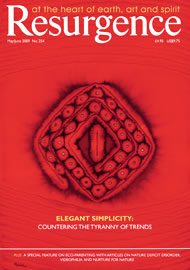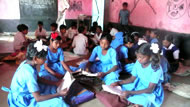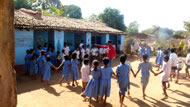THE PATCHWORK OF tiny fields around Chhuinara village in western Orissa, India, lie parched and exhausted, only bleached stubble is left behind after the paddy harvest. It is late October, and there has been no rain since the Dussera festival several weeks ago. When the few labourers still threshing grain and baling the rice straw complete their tasks, there will be no more agricultural work until the monsoon rains return in June. Where no irrigation is available, a second or third crop cannot be grown. So the fields sit, unproductive, through the gentle winter months and then the punishing heat of summer.
Most of the traditional mud-walled homes in Chhuinara’s main street are padlocked; one broken door is barricaded with a thorny bundle of twigs and branches. The families who live here, mainly landless agricultural labourers, have left to find work in the brick kilns of the neighbouring state of Andhra Pradesh. This is an annual exodus known as distress seasonal migration. Forty-four per cent of the children registered at the village primary school have gone with their parents. In previous years, eleven-year-old Susila was one of those absent, but this year the school is doubling as a temporary hostel for twenty-five children whose migrating parents allowed them to stay behind to continue their schooling.
Distress seasonal migration is a survival strategy of the poorest of the poor. It affects 100,000-150,000 people from five districts in Western Orissa alone, and thousands in other rural states. Up to 80% of the population of some villages have no alternative but to seek work elsewhere during the long dry season. Often, only the infirm, people with disabilities and the very old are left behind, to manage as best they can. The material, social and cultural life of these villages deteriorates. Festivals pass uncelebrated, fairs are cancelled, village assets are not maintained, panchayat or village council activity ceases, and schools and health centres fall into disuse.
The obvious cause is drought; there is practically no rain for eight months of the year, since deforestation has devastated the intricate interaction between tree cover, climate and the retention of water in living, fertile soil. But these areas are also marginalised, home mainly to people from ‘Scheduled Tribes’, ‘Scheduled Castes’ and what are called ‘Other Backward Castes’. Here, drought has an alternative meaning: the prolonged, serious lack of many things. Jatin Patra, director of the local, rights-based non-governmental organisation (NGO) Adhikar, calls this endemic poverty and social deprivation “total system failure”.
“Villagers used to be dependent on each other,” he explains. “Some families provided milk or vegetables, others bamboo or non-timber forest products, or they pressed oils, conducted prayers, made earthenware. But timber-cutting rights were sold to contractors, and globalisation and the multinational corporations broke that mutual support. People have been displaced from their land by large-scale mining, big dams and heavy industry. Now there aren’t enough work opportunities, crops are sold at distress prices, livelihoods have collapsed and there is no food security or social security.”
SYSTEMATICALLY EXPLOITING THIS vulnerability, contractors and agents acting on behalf of brick-kiln owners converge on Bolangir district at the end of the monsoon season. A small loan of just a few hundred rupees is enough to secure the commitment of labour. A month or so later an advance of a few thousand rupees bonds the labourers even tighter. The families have no bargaining power so they take what is offered. This is usually just enough to pay off old debts, buy food, medicine and some new clothes, and perhaps make a puja or celebrate a wedding, so it is often spent before the migration even begins. Come November, the families herd onto trains, buses and bullock carts and make the 600-kilometre journey to the brick kilns. A subsistence allowance only is paid during the months of hard labour. When the final account is tallied, deductions are made for ‘expenses’ and frequently there is little or no surplus to take home. Hence the spiral of indebtedness goes round again, as it has done for many years – even generations.
Around 25,000 children from Bolangir district go with their parents each year, to live in brutal physical conditions at the work sites. Contractors hire a work unit that consists of a man, woman and child – a breach of child rights in which kiln owners are complicit. Since the pay is based on piece work, by the brick, every pair of hands counts. Even if accompanying children are not involved in brick-making, girls look after the babies and help with cooking. So parents may need convincing reasons to forego the labour of a child now, in order to increase future prospects.
Susila’s parents gave her that opportunity three years ago. Adhikar established a Residential Care Centre (RCC) at her school, and won over her parents. The classrooms became night-time dormitories, a ‘mother’ provided meals and care, and a co-ordinator liaised with school staff and the community. This year, the state government has provided some support, and Susila is able to carry on with the reading, mathematics and other subjects she enjoys. But her brothers, aged six and four years, and her one-year-old sister were all taken to the brick kilns this year.
Before RCCs were established in Kalipathar village, Phula migrated with her family to make bricks near Bangalore. She says the work was hard, the environment difficult. She had problems with the language, she had no friends there, and her education stopped for six months. Another girl, Manju, adds that her family worked day and night, for only thirty rupees a day, and she became traumatised and had to be sent home after one month. Women and girls are often doubly disadvantaged and vulnerable to physical and sexual abuse.
NGOs are also mobilising Village Education Committees to improve government schools generally, for the benefit of all children, migrant and non-migrant. Adhikar calls this ‘RCC Plus’. Parents are more likely to let their children continue with their studies if the school is performing well and producing results. Manju and Phula, now fourteen years old, are allowed to stay with Manju’s grandmother in the village during migration. They enjoy Oriya, English, science and dance; they want to become doctors. They have an opportunity to escape the trap in which their parents and siblings are still caught.
One of the interventions that could release whole communities from the destructiveness of distress seasonal migration can be seen in the landscape thirty kilometres from Kalipathar. The fields are full of labourers, ankle deep in mud, planting a summer crop of vivid green paddy shoots. This new lease of life is made possible by a small-scale Minor Irrigation Project. Adhikar and similar NGOs are facilitating other initiatives, too: they conduct social audits of government schemes, such as the National Rural Employment Guarantee Act. Ensuring that people’s entitlements to 100 days of work are accessed and paid for can make the difference between destitution and subsistence. These NGOs also establish alternative livelihood projects, often through women’s self-help groups. Patra explains, “The aim is to make migration a choice, from a position of strength, not as a result of distress.”
INDIA’S ECONOMIC MIRACLE still only benefits the minority. But uneven development encourages distress seasonal migration, as cheap labour from impoverished areas is sought for hubs of industrial or agricultural productivity. The integrity of certain, mainly tribal, communities, in states like Orissa, Jharkhand and Bihar, is compromised. But targeted, inventive approaches are beginning to counter this trend and are helping to develop sustainable local economies and environments. Thanks to the sustainable interventions that are taking place, people are starting to have choices about their future. As Patra says, “It is about providing a life of dignity for all people.” •









